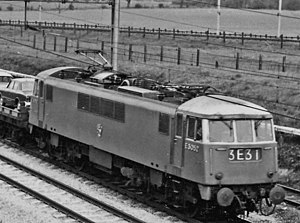| British Railways AL2 British Rail Class 82 | |||||||||||||||||||||||||||||||||||||||||
|---|---|---|---|---|---|---|---|---|---|---|---|---|---|---|---|---|---|---|---|---|---|---|---|---|---|---|---|---|---|---|---|---|---|---|---|---|---|---|---|---|---|
 E3052 at Hartford Junction in 1965 | |||||||||||||||||||||||||||||||||||||||||
| |||||||||||||||||||||||||||||||||||||||||
| |||||||||||||||||||||||||||||||||||||||||
| |||||||||||||||||||||||||||||||||||||||||
| |||||||||||||||||||||||||||||||||||||||||
The British Rail Class 82 (AL2 under the pre-TOPS classification scheme) electric locomotives were designed by the British manufacturing interest Metropolitan-Vickers and produced by Beyer, Peacock and Company on behalf of British Rail (BR).
The locomotive was developed as a part of the programme of works to electrify the West Coast Main Line during the late 1950s and early 1960s. BR deliberately opted to procure multiple small batches of locomotives from a range of manufacturers. Having selected a proposal by the Metropolitan-Vickers division of the British manufacturing interest Associated Electrical Industries (AEI), the Class 82 would be produced. A total of ten locomotives were built by Beyer, Peacock and Company between 1960 and 1962.
The Class 82 proved to be a relatively reliable workhorse of the region, particularly following a refurbishment during the 1970s that saw the replacement of their rectifiers. The fleet served in their original capacity for roughly twenty years, being mostly withdrawn during the early 1980s following the arrival of newer types such as the British Rail Class 87. Following the final retirement of the Class 82 in 1987, a single example was preserved.